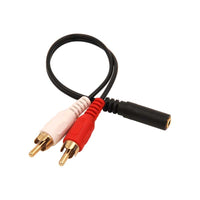Contents
In the digital age, you can use computers or laptops to enjoy different kinds of audio content. However, there are so many audio ports on computers or laptops that it can be overwhelming for newcomers to connect their audio devices and systems. Choosing the right audio port for your headphones or speakers on your computer is crucial for achieving high-end sound quality. This article provides a thoughtful guide.
What is an Audio Port?
Audio ports are physical interfaces on devices that allow the transmission of audio signals between different devices. Audio ports perform two basic functions: input and output. Audio output refers to the process of transmitting sound signals from one device to other playback devices. For example, it allows for audio signal transmission to external audio devices such as headphones, speakers and amplifiers. On the other hand, audio input is the process of feeding sounds into a device in the form of audio signals that can be processed by the device. For instance, it facilitates the transmission of audio signals from external sources such as microphones and musical instruments into the computer or recording system.
Audio ports enable a wide range of activities, including audio playback, audio processing, and sound recording. In general, a computer is equipped with sound cards or audio circuits in the motherboard. Desktop computers typically feature audio ports on both the front and back of their CPU boxes.
Motherboard Audio Ports
Motherboard audio ports can be divided into analog and digital types. The 3.5 mm audio port is the most common analog audio port on motherboards, designed to be compatible with 3.5mm TRS audio plugs. A desktop computer CPU usually has two distinct 3.5 mm audio jacks on the front: one is used for audio output, connecting the PC headphone port, and another marked with a microphone icon is designed for audio input. The 3.5 mm audio ports of the rear CPU are usually color-coded to indicate their different functions.
Another kind of analog audio port, the 6.35 mm audio port is relatively rare. This computer audio port is suitable for high-end headphones and other professional audio equipment. Compared to standard 3.5 mm audio out, it features higher power output to reduce resistance and inductance and drive high-quality audio equipment. As an alternative to this jack, people sometimes use a 6.35 mm to 3.5 mm adapter to assist the connection.
Digital ports on computers transmit audio signals in digital format. They can provide high-quality audio signals for external devices, such as sound cards, audio and video players, decoders, multimedia speakers and so on. The two main digital ports, coaxial and digital optical outputs are less common on computers. But the USB port also acts as a digital audio port and provides versatile connectivity for a wide range of devices.
S/PDIF, short for Sony/Philips Digital Interconnect Format, is the common digital audio out interface on mid-range and high-end motherboards. S/PDIF supports multi-channel audio transmission over a single cable, which facilitates home theater connections. Both optical and coaxial cables can be used to carry S/PDIF signals. Optical S/PDIF, also known as TOSLINK, is less susceptible to interference, making it ideal for HiFi applications. Coaxial digital outs tend to work via coaxial cables and RCA jacks, but sometimes they exist in the form of BNC ports.
Audio Ports on Laptops
Audio ports are also necessary for laptops to connect different audio devices, such as headphones and microphones. Many laptops are equipped with 3.5 mm TRRS audio ports to handle both audio input and audio output. It is suited for headphones with built-in microphones. However, if you want to connect a headset with two plugs, a 2-in-1 adapter may be needed.
Some new laptops are not even equipped with a traditional audio port. Instead, they use the USB or HDMI ports to transmit audio signals. Additionally, Bluetooth technology allows laptops to connect headphones and speakers without the need for a cable.
Take MacBook as an example, it usually includes one to three audio ports to connect headphones, speakers, and audio systems.
- Headphone Port: It is used with 3.5 mm audio plugs. The port can support headphones with or without microphones.
- Audio In: The port is used to connect external audio sources to your MacBook. It can be connected to stereo devices with RCA plugs or even the TOSLINK optical digital inputs using different stereo miniplug adapters.
- Analog Audio Out: This port is typically labeled with a volume icon. It is used to connect speakers or other audio devices via a 3.5 mm audio plug.
How to Identify Audio Ports Based on Color Codes?
There are at least three 3.5mm sound ports on PCs, typically in the colors of green, blue, and pink. Different audio port colors indicate their different functions. Green is designed for audio output, blue is for line-in, and pink is for microphone input. Many motherboards also come with additional ports in other color codes to support surround sound settings. Here is a detailed overview of these audio ports and their functions.
- Green - Line Out
The green port, also known as the “line-out” or “audio-out” port, is used to transmit audio signals from a computer to other audio devices, such as earphones, speakers, and other audio playback devices. The green audio port is usually used with 3.5mm audio cables and is suitable for 2-channel (stereo) systems. In addition to the green color, it can sometimes be indicated as sound waves with an outward arrow.
- Pink - Mic In
The pink port is designed to connect the microphone and computer. This mic-in port is used to record audio from microphones or headphones with microphones. It is optimized for microphone audio amplification, providing clear and high-quality recordings. The port can be labeled with "Mic-In" or a microphone icon for easy identification.
- Blue - Line In
The blue port or line-in port is also crucial for audio transmission, allowing computers to receive audio inputs from other audio devices to play, record and process sounds. The blue port is used to connect to external equipment, such as CD/DVD players, MP3s, amplifiers, musical instruments, and mixers. While the blue port can also be used for connecting microphones, it usually delivers lower-quality transmission compared to the pink port. Contrary to the line-out port, the line-in port can be indicated as sound waves with an inward arrow.

- Orange - CS Out
The orange port is used to connect center/front speakers or subwoofers. This port is usually described and labeled as cs-out (center channel speaker out) or c/sub (center channel speaker/subwoofer). It is often used to support sounds playing in the center or to add more bass to the audio system.
- Black - RS Out
The black port or rear speaker out port can be indicated with the "RS-Out" or “rear” icon. It is used for connecting rear speakers, designed for 5.1 and 7.1 surround sound systems.
- Gray/Silver/White - SS Out
The gray/silver/white port is the one you will use when you have side speakers, so it generally comes into play in a 7.1-channel audio system. It may be labeled "SS-Out" (side speaker out) or simply "side”. Like the above two surround speaker ports, it often features a speaker icon.

The good news is that some new motherboards have integrated new capabilities allowing users to customize port functionality. In this way, you can go beyond the functional limitations of audio ports and employ them according to your needs by modifying the sound card driver settings. This brings convenience to users and improves the utilization of idle audio ports.
Conclusion
Audio ports on PCs and laptops provide essential connectivity for various audio devices, including speakers and microphones. These diverse audio ports help enhance your audio experience, and knowing their functions can help you better set up the sound configuration. Now that you have read the article, it is the perfect time to set up your audio connection and enjoy superior sound!
For more information on this topic, you can keep up on our blogs. While VCELINK offers general and basic information for our customers and other visitors to the website, it’s not professional advice.





Be the first one to comment.
Leave a comment